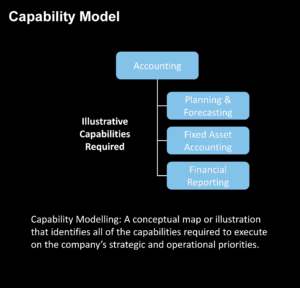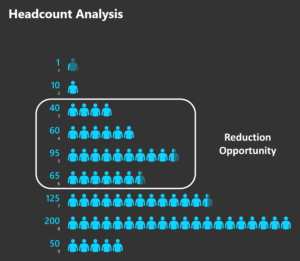Being a leader during these turbulent times is tough. There is no defined playbook, you are trying to keep people safe, morale high, and protect cashflow. If you happen to be a leader in Alberta, it feels even more daunting as you are having to battle on multiple fronts (e.g. a pandemic, an oil price war, and varying support for Alberta’s primary industry within our own country). You are being pulled in multiple directions and trying to do ‘what’s right’.
Then there is the added challenge of predicting what the future entails. What will be the demand for your products and services? Will there be multiple waves of the pandemic resulting in stops and starts? If so, how will it impact your business? How will this pandemic change how you need to operate? How will your cost structure change and what does it need to be?
This is about managing things you can control, and monitoring those that you cannot. One of the controllable items leaders must look at in this uncertain environment is headcount. Many leaders were quick to react and able to cut headcount quickly, while others know they must reduce their headcount but don’t know how to cut more after already going through multiple rounds of restructuring due to the economic recession we were already facing in Alberta.
Headcounts have been reduced and single individuals are already doing jobs that were previously divided between two to three people. The “low hanging fruit” is long gone. This time around, there will be no easy ‘fat’ to trim from the organization and this creates real risks. Organizations will be hollowed out to achieve efficiencies today at the detriment of growth and stability in the future, and employee morale will be at an all-time low.
Our clients have been asking us how to restructure their organizations in this tumultuous environment, when it feels like there isn’t anything left to cut.
What is Organizational Restructuring?
Before we explain how to do this, let’s make sure we all are talking about the same thing. Organizational restructuring in this context, refers to rethinking and implementing changes to your company’s operating model and organizational structure to achieve a desired outcome (e.g. enable a new strategic direction, break down organizational silos, reduce costs, etc.).
Even more specifically in this context, how do you cut headcount while still having the capabilities and capacity to achieve your company’s goals and deliver on your mandate.
How to Restructure Your Organization
1. Ground the restructuring in the organization’s strategy:
Before undertaking an organizational restructuring, make sure everyone is re-acquainted with and clear on the organization’s short and long-term strategy. Clearly identify where value is created and how these value-creating activities are enabled. This will help you prioritize where to look for efficiencies and which elements of the business need to stay intact for when the business ramps up again.

2. Focus on capabilities, not people in boxes:
You will fail if it becomes about names in boxes. Of course, it is easy for us to say that when we work outside the organization and don’t have to look those people in the eyes if the decision is to say goodbye. Identify which capabilities the company requires to execute on its strategic and operational priorities.
It’s also important to assess which capabilities are ‘mission critical’ vs. ‘nice-to-have’. When you have a clear picture of what capabilities you require, it will give you better perspective of what work needs to be done and who should be filling which seats on the bus moving forward.
3. Look at value from the bottom up:
Most restructuring initiatives take a top-down approach where leaders identify which cuts can be made below them to achieve a defined target. This approach results in self-preservation and potentially destroys value. We recommend taking an inverted look at the organization by flipping the organizational structure on its head. Assess the value of a role based on how they drive value for the customer and the organization (i.e. front-line staff) and determine how many of those resources are required. Then assess what management oversight is truly required. Looking at the organization from this perspective can give you new insights into which individuals, roles, and functions are truly driving value and should be maintained.
4. Physically count how many layers and the number of people at each layer:

Assessing your organizational structure from a quantitative perspective provides clarity regarding where there is ‘fat’ in the organization and helps disconnect the assessment from the people in the boxes. Count how many layers are from the CEO to the front-line-work (i.e. the individuals that interact with customers and do the work) and determine what is appropriate for your organization. Are you really that efficient if a decision needs to go up five layers to get something done? Also, count how many resources are at each level, you will likely be surprised how many people are in the middle layers. Now you know where to put your magnify glass for further inspection. For example, in this diagram they have 260 management level resources and an average span of control less than 1:2.
5. Create multiple alternative organizational structures to evaluate:
While time is of the essence, understanding the tradeoffs that exist with different alternatives will provide insight into how things might work in the future and where you might be at risk of achieving your strategic and operational priorities. By evaluating alternatives, you can do scenario analysis to see what potential cost savings you can achieve against your cost baseline, and what you might be possibly giving up by pursuing those savings.
6. Remember, the work needs to change for good:
Once you have picked what your organizational structure is going to be and which cuts need to be made, remember that when all the ‘fat’ is gone out of the company, it no longer has the energy for the old way of doing things. Consider that your organization many need to operate in fundamentally new and different ways. Processes will need to be evaluated and updated with a long-term focus to ensure that the ‘fat’ does not creep back into the company when times are good again.
7. Be clear and compelling on the why:
While the reasons for making these difficult decisions may seem clear in a pandemic, remember that rational thought sometimes goes out the window when conversations are focusing on people’s jobs and ability to provide for their family. The message is always difficult, and some will never accept it, but if you can’t communicate why you are restructuring in a way that everyone can understand and relate to, then you can expect serious pushback, disengagement, and poor morale for those that stay with the organization.
Other Tips and Tricks:
- Set a target but do the hard work to validate if that number is correct: There may be a specific number that needs to be hit but see what this process results in before arbitrarily going after some number.
- Don’t keep score: Often there is tendency to try and achieve proportionate cuts across functional areas of the business. Or, leaders say, “ I had to cut half my team, why haven’t you?” Headcount reduction is about using a scalpel and rethinking how you operate and do you have the right roles and capabilities to enable the strategic and operational priorities. The organization loses when everyone is racing to the bottom.
- Spend time getting titles, responsibilities and accountability right: If you flatten your organization and rethink how work should be done, you need to tackle the title problem (e.g. Supervisor, Manager, Sr. Manager) and be clear on new responsibilities as you implement your new organization. The more time an organization spends up front figuring out who’s doing what, at what level, and with what authority, the smoother the transition will be on the other side.
The ideas presented in this post are intended to help you not only find those additional opportunities for headcount reduction, but also rethink how you operate so you can create value and thrive in the future when the economy bounces back.
And, if you only take one or two ideas from this post: (1) flip the organization upside down and see if you see new opportunity; and, (2) remember to treat people how you would like to be treated throughout this process.
Originally posted by Mike Glover on Dec 6, 2018 and updated by Dustin Anderson on May 1, 2020: https://www.linkedin.com/pulse/time-new-playbook-reorganizing-when-feels-like-theres-glover-mba/



